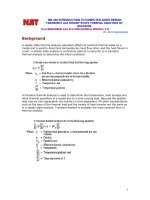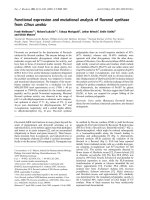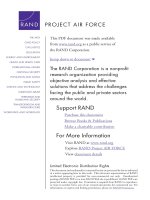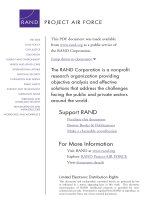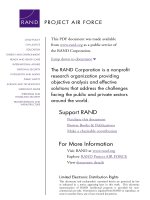Supporting Air and Space Expeditionary Forces - Analysis of CONUS Centralized Intermediate Repair Facilities ppt
Bạn đang xem bản rút gọn của tài liệu. Xem và tải ngay bản đầy đủ của tài liệu tại đây (2.66 MB, 274 trang )
This document and trademark(s) contained herein are protected by law as indicated
in a notice appearing later in this work. This electronic representation of RAND
intellectual property is provided for non-commercial use only. Unauthorized
posting of RAND PDFs to a non-RAND Web site is prohibited. RAND PDFs are
protected under copyright law. Permission is required from RAND to reproduce,
or reuse in another form, any of our research documents for commercial use. For
information on reprint and linking permissions, please see RAND Permissions.
Limited Electronic Distribution Rights
Visit RAND at www.rand.org
Explore RAND Project AIR FORCE
View document details
For More Information
This PDF document was made available
from www.rand.org as a public service of
the RAND Corporation.
6
Jump down to document
THE ARTS
CHILD POLICY
CIVIL JUSTICE
EDUCATION
ENERGY AND ENVIRONMENT
HEALTH AND HEALTH CARE
INTERNATIONAL AFFAIRS
NATIONAL SECURITY
POPULATION AND AGING
PUBLIC SAFETY
SCIENCE AND TECHNOLOGY
SUBSTANCE ABUSE
TERRORISM AND
HOMELAND SECURITY
TRANSPORTATION AND
INFRASTRUCTURE
WORKFORCE AND WORKPLACE
The RAND Corporation is a nonprofit
research organization providing
objective analysis and effective
solutions that address the challenges
facing the public and private sectors
around the world.
Purchase this document
Browse Books & Publications
Make a charitable contribution
Support RAND
This product is part of the RAND Corporation monograph series.
RAND monographs present major research findings that address the
challenges facing the public and private sectors. All RAND mono-
graphs undergo rigorous peer review to ensure high standards for
research quality and objectivity.
Supporting Air and Space
Expeditionary Forces
Analysis of CONUS Centralized
Intermediate Repair Facilities
Ronald G. McGarvey
t
James M. Masters
t
Louis Luangkesorn
Stephen Sheehy
t
John G. Drew
t
Robert Kerchner
Ben Van Roo
t
Charles Robert Roll, Jr.
PROJECT AIR FORCE
Prepared for the United States Air Force
Approved for public release; distribution unlimited
The RAND Corporation is a nonprofit research organization providing
objective analysis and effective solutions that address the challenges
facing the public and private sectors around the world. RAND’s
publications do not necessarily reflect the opinions of its research clients
and sponsors.
R
®
is a registered trademark.
© Copyright 2008 RAND Corporation
All rights reserved. No part of this book may be reproduced in any
form by any electronic or mechanical means (including photocopying,
recording, or information storage and retrieval) without permission in
writing from RAND.
Published 2008 by the RAND Corporation
1776 Main Street, P.O. Box 2138, Santa Monica, CA 90407-2138
1200 South Hayes Street, Arlington, VA 22202-5050
4570 Fifth Avenue, Suite 600, Pittsburgh, PA 15213-2665
RAND URL:
To order RAND documents or to obtain additional information, contact
Distribution Services: Telephone: (310) 451-7002;
Fax: (310) 451-6915; Email:
The research described in this report was sponsored by the United States
Air Force under Contracts FA7014-06-C-0001 and F49642-01-C-0003.
Further information may be obtained from the Strategic Planning
Division, Directorate of Plans, Hq USAF.
Library of Congress Cataloging-in-Publication Data
Supporting air and space expeditionary forces : analysis of CONUS centralized
intermediate repair facilities / Ronald G. McGarvey [et al.].
p. cm.
Includes bibliographical references.
ISBN 978-0-8330-4290-3 (pbk. : alk. paper)
1. United States. Air Force—Supplies and stores. 2. Airplanes, Military—United
States—Maintenance and repair. 3. United States. Air Force—Facilities.
I. McGarvey, Ronald G. II. Title: Supporting air and space expeditionary forces,
analysis of CONUS CIRFs.
UG1123.S88 2008
358.4'183—dc22
2008035565
iii
Preface
is monograph describes a series of analyses performed for the United
States Air Force (USAF) and sponsored by the Deputy Chief of Staff
for Installations and Logistics (AF/IL).
1
ese analyses focused on
designing a set of networks of Centralized Intermediate Repair Facili-
ties (CIRFs) that would provide centralized off-equipment repair of
major aircraft components in the continental United States (CONUS).
e premise for the investigation was that well-designed CONUS
CIRF networks could provide maintenance support more efficiently
and effectively than can the traditionally used procedures, which gen-
erally rely on decentralized, or local, maintenance facilities. Although
the USAF has experience with operating CIRFs in both the CONUS
and overseas, Air Force leadership did not have an analytic method for
designing cost-effective CIRF networks or readily comparing alterna-
tive potential network designs. e RAND Corporation was asked to
develop such an approach and to perform the analyses.
is monograph describes the new modeling approach developed
to construct the CONUS CIRF network designs and presents detailed
results from the specific analyses. e analyses are based on F-15, F-16,
and A-10 aircraft force structure bed-downs resulting from the Defense
Base Closure and Realignment Commission’s 2005 recommendations.
For the three aircraft types, all CONUS active duty bases, Air National
Guard (ANG) installations, and Air Force Reserve Command (AFRC)
installations possessing combat-coded or training aircraft, along with
1
e current title of this office is Deputy Chief of Staff for Logistics, Installations and Mis-
sion Support (AF/A4/7).
iv Supporting Air and Space Expeditionary Forces
some Air Force Materiel Command (AFMC) bases, were used as loca-
tions to be supported by CIRF networks. CIRF network designs were
constructed for aircraft engines (TF34, F100, F110), electronic war-
fare (EW) pods (ALQ-131, ALQ-184), Low Altitude Navigation and
Targeting Infrared for Night (LANTIRN) navigation (AN/AAQ-13)
and targeting pods (AAQ-14s), and F-15 avionics line replaceable
units (LRUs). is set of commodities was chosen because previous
analyses (many of which were performed at RAND) had suggested that
they afforded the largest potential savings from consolidated mainte-
nance. Tasking scenarios considered in these analyses included normal
peacetime training and readiness, Air and Space Expeditionary Force
(AEF) deployment taskings, and major regional conflict (MRC) task-
ings. e research, completed in March 2006, was conducted within
the Resource Management Program of RAND Project AIR FORCE
as part of a research project, begun in fiscal year 2005, titled “CONUS
CIRF Implementation Analysis.”
is monograph should be of interest to such functional-area
subject matter experts as combat support planners, logisticians, mobil-
ity planners, and operations planners; leaders and key staff officers at
the Headquarters Air Force, Major Command, and operational levels;
maintenance personnel; and operators throughout the Department of
Defense (DoD), especially those in the ANG, Air Force Reserve, and
active duty Air Force.
is monograph is one in a series of RAND reports addressing
agile combat support (ACS) issues in implementing the AEF. Related
publications include the following:
Supporting Expeditionary Aerospace Forces: An Integrated Strategic t
Agile Combat Support Planning Framework, Robert S. Tripp et al.
(MR-1056-AF). is report describes a framework for integrated
combat-support planning that may be used to evaluate support
options on a continuing basis, particularly as technology, force
structure, and threats change.
Supporting Expeditionary Aerospace Forces: New Agile Combat Sup-t
port Postures, Lionel Galway et al. (MR-1075-AF). is report
describes how alternative resourcing of forward operating loca-
Preface v
tions can support employment timelines for future AEF opera-
tions. It finds that rapid employment for combat requires some
prepositioning of resources at forward operating locations.
Supporting Expeditionary Aerospace Forces: An Analysis of F-15 Avi-t
onics Options, Eric Peltz et al. (MR-1174-AF). is report exam-
ines alternatives for meeting F-15 avionics maintenance require-
ments across a range of likely scenarios. It evaluates investments
for new F-15 avionics intermediate shop test equipment against
several support options, including deploying maintenance capa-
bilities with units, performing maintenance at forward support
locations (FSLs), and performing all maintenance at the home
station for deploying units.
Supporting Expeditionary Aerospace Forces: A Concept for Evolving t
to the Agile Combat Support/Mobility System of the Future, Robert
S. Tripp et al. (MR-1179-AF). is report describes the vision for
the ACS system of the future based on individual commodity
study results.
Supporting Expeditionary Aerospace Forces: Expanded Analysis of t
LANTIRN Options, Amatzia Feinberg et al. (MR-1225-AF). is
report examines alternatives for meeting LANTIRN support
requirements for AEF operations. It evaluates investments for
new LANTIRN test equipment against several support options,
including deploying maintenance capabilities with units, per-
forming maintenance at FSLs, and performing all maintenance
at CONUS support hubs for deploying units.
Supporting Expeditionary Aerospace Forces: Lessons From the Air t
War Over Serbia, Amatzia Feinberg et al. (not available to the
general public). is report describes how the Air Force’s ad hoc
implementation of many elements of an expeditionary ACS struc-
ture to support the air war over Serbia offered opportunities to
assess how well these elements actually supported combat oper-
ations and what the results imply for the configuration of the
USAF ACS structure. e findings support the efficacy of the
emerging expeditionary ACS structural framework and the asso-
ciated but still-evolving USAF support strategies.
vi Supporting Air and Space Expeditionary Forces
Supporting Expeditionary Aerospace Forces: Alternatives for Jet t
Engine Intermediate Maintenance, Mahyar A. Amouzegar et al.
(MR-1431-AF). is report evaluates the manner in which jet
engine intermediate maintenance (JEIM) shops can best be con-
figured to facilitate overseas deployments. It examines a number
of JEIM support options, which are distinguished primarily by
the degree to which JEIM support is centralized or decentral-
ized. See also Engine Maintenance Systems Evaluation (En Masse):
A User’s Guide, Amouzegar and Galway (MR-1614-AF).
A Combat Support Command and Control Architecture for Sup-t
porting the Expeditionary Aerospace Force, James Leftwich et al.
(MR-1536-AF). is report outlines the framework for evaluating
options for combat support execution planning and control. It
describes the combat support command-and-control operational
architecture as it is now and as it should be in the future. It also
describes the changes that must take place to achieve that future
state.
Reconfiguring Footprint to Speed Expeditionary Aerospace Forces t
Deployment, Lionel A. Galway et al. (MR-1625-AF). is report
develops an analysis framework—as a footprint configuration—to
assist in devising and evaluating strategies for footprint reduction.
It attempts to define footprint and to establish a way to monitor
footprint reduction.
Analysis of Maintenance Forward Support Location Operationst ,
Amanda Geller et al. (MG-151-AF). is monograph discusses
the conceptual development and recent implementation of main-
tenance forward support locations (also known as CIRFs) for the
USAF. e analysis focuses on the years leading up to and includ-
ing the AF/IL CIRF test, which tested the operations of CIRFs in
the European theater from September 2001 to February 2002.
Supporting Air and Space Expeditionary Forces: Lessons from Oper-t
ation Enduring Freedom, Robert S. Tripp et al. (MR-1819-AF).
is report describes the expeditionary ACS experiences during
the war in Afghanistan and compares them with those associated
with Joint Task Force Noble Anvil, the air war over Serbia. It
analyzes how ACS concepts were implemented, compares current
Preface vii
experiences to determine similarities and unique practices, and
indicates how well the ACS framework performed during these
contingency operations. e analysis can be used to update the
ACS framework to better support the AEF concept.
Supporting Air and Space Expeditionary Forces: A Methodology for t
Determining Air Force Deployment Requirements, Don Snyder and
Patrick Mills (MG-176-AF). is monograph outlines a meth-
odology for determining manpower and equipment deployment
requirements. It describes a prototype policy analysis support tool
based on this methodology, the Strategic Tool for the Analysis of
Required Transportation (START), that generates a list of capa-
bility units, called unit type codes (UTCs), required to support
a user-specified operation. e prototype also determines move-
ment characteristics. A fully implemented tool based on this pro-
totype should prove to be useful to the USAF in both deliberate
and crisis action planning.
Supporting Air and Space Expeditionary Forces: Lessons from Opera-t
tion Iraqi Freedom, Kristin F. Lynch et al. (MG-193-AF). is
monograph describes the expeditionary ACS experiences during
the war in Iraq and compares them with those associated with
Joint Task Force Noble Anvil in Serbia and Operation Enduring
Freedom in Afghanistan. is monograph analyzes how combat
support performed and how ACS concepts were implemented in
Iraq, compares current experiences to determine similarities and
unique practices, and indicates how well the ACS framework per-
formed during these contingency operations.
Supporting Air and Space Expeditionary Forces: Analysis of t
Combat Support Basing Options, Mahyar A. Amouzegar et al.
(MG-261-AF). is monograph evaluates a set of global FSL
basing and transportation options for storing war reserve mate-
riel. It presents an analytic framework that can be used to evaluate
alternative FSL options; a central component of the framework is
an optimization model that allows users to select the best mix of
land- and sea-based FSLs for a given set of operational scenarios,
thereby reducing costs while supporting a range of contingency
operations.
viii Supporting Air and Space Expeditionary Forces
Unmanned Aerial Vehicle End-to-End Support Considerations, t
John G. Drew et al. (MG-350-AF). is monograph presents
the results of a review of current support postures for unmanned
aerial vehicles and evaluates methods for improving current pos-
tures that may also be applied to future systems.
Strategic Analysis of Air National Guard Combat Support and t
Reachback Functions, Robert S. Tripp et al. (MG-375-AF). is
monograph analyzes transformational options for better meeting
combat support mission needs for the AEF. e role the ANG
may play in these transformational options is evaluated in terms
of effective and efficient approaches for achieving the desired
operational effects. Four Air Force mission areas are evaluated:
CONUS CIRFs, civil engineering deployment and sustainment
capabilities, GUARDIAN (an ANG information system used to
track and control the execution of plans and operations, such as
funding and performance data) capabilities, and air and Space
Operations Center reachback missions.
A Framework for Enhancing Airlift Planning and Execution Capa-t
bilities Within the Joint Expeditionary Movement System, Robert
S. Tripp et al. (MG-377-AF). is monograph examines options
for improving the effectiveness and efficiency of intra-theater air-
lift operations within the military joint end-to-end multi-modal
movement system. Using the strategies-to-tasks framework, this
monograph identifies shortfalls and suggests, describes, and evalu-
ates options for implementing improvements in current processes,
doctrine, organizations, training, and systems.
Supporting Air and Space Expeditionary Forces: An Expanded t
Operational Architecture for Combat Support Planning and Execu-
tion Control, Patrick Mills et al. (MG-316-AF). is monograph
expands and provides more detail on several organizational nodes
described in earlier work that outlined concepts for an operational
architecture for guiding the development of USAF combat support
execution planning and control needed to enable rapid deploy-
ment and employment of the AEF. ese combat support execu-
tion planning and control processes are sometimes referred to as
Combat Support Command and Control (CSC2) processes.
Preface ix
RAND Project AIR FORCE
RAND Project AIR FORCE (PAF), a division of the RAND Cor-
poration, is the U.S. Air Force’s federally funded research and devel-
opment center for studies and analyses. PAF provides the Air Force
with independent analyses of policy alternatives affecting the devel-
opment, employment, combat readiness, and support of current and
future aerospace forces. Research is conducted in four programs: Force
Modernization and Employment; Manpower, Personnel and Training;
Resource Management; and Strategy and Doctrine.
Additional information about PAF is available on our Web site:
/>
xi
Contents
Preface iii
Figures
xv
Tables
xvii
Summary
xix
Acknowledgments
xxiii
Abbreviations
xxvii
CHAPTER ONE
e CONUS CIRF Concept 1
Introduction
1
Background
5
USAF ree-Level Maintenance Concept
5
Intermediate-Level Maintenance Deployment Concepts and
Experience
7
Prior CIRF Studies and Analyses
9
Preview of Findings
11
General Findings
11
Specific Findings
13
Organization of is Monograph
15
CHAPTER TWO
e Q-METRIC Modeling Approach 17
CIRF Network Design as a Facility Location Problem
17
Monte Carlo Simulation Approaches to Logistics Network Design
18
MILP Approaches to Logistics Network Design
20
METRIC-Like Approaches to Logistics Network Design
21
xii Supporting Air and Space Expeditionary Forces
Q-METRIC: A CIRF Network Design Algorithm 22
CHAPTER THREE
Results of Engine Analyses 27
Overview of Post-BRAC Bed-Downs and CIRF Assignments
27
JEIM Cost and Performance Measures
29
Retained Tasks and Dispatch Teams
35
Cost-Performance Tradeoff Evaluated Against Deployment Scenario
36
Alternative Maintenance Policies
42
No Retained Tasks CONUS
42
No Retained Tasks OCONUS
46
All Repair in CONUS
49
Part-Time Manning Implications
51
Output Tables
51
Impact of Engine Repair Times
52
CHAPTER FOUR
Electronic Warfare Pods 59
EW Pod Requirements Post-BRAC
62
EW Pod Cost and Performance Measures
65
Cost-Performance Tradeoff Evaluated Against Deployment Scenario
68
Deployment Manpower Considerations
74
Part-Time Manning Considerations
76
Output Tables
78
CHAPTER FIVE
F-15 Avionics and LANTIRN Results 83
F-15 Avionics
83
Concept of Operations
84
Alternative CIRF Configuration
87
Evaluation of BCS Screening of Avionics LRUs
89
OCONUS Manning Issues
92
LANTIRN
94
Concept of Operations
96
Results
97
OCONUS Manning Issues
100
Contents xiii
Other Considerations 101
CHAPTER SIX
Findings, Recommendations, and Concluding Comments 105
General Findings
105
Specific Findings
109
Concluding Comments
112
APPENDIXES
A. Technical Description of Q-METRIC Modeling Tools 113
B.
Assessment Scenarios and Sources of Input Data 125
C. Detailed Results of JEIM Analyses
147
D. Detailed Results of ECM Pod Analyses
203
Bibliography
237
xv
Figures
1.1. Notional Results of a Typical CONUS CIRF
Commodity Analysis
12
2.1. CONUS CIRF Modeling Framework
24
3.1. Post-BRAC Network, F110 Engine
29
3.2. Post-BRAC Network, F100 Engine
30
3.3. Post-BRAC Network, TF34 Engine
31
3.4. Deployment Scenario, F110-100 CIRF Network Options
38
3.5. Deployment Scenario, F110-129 CIRF Network Options
39
3.6. Alternative CIRF Network, F110 Engine
40
3.7. Alternative CIRF Network, F100 Engine
42
3.8. Alternative CIRF Network, TF34 Engine
43
3.9. Policy of No Retained Tasks CONUS, F110-100 CIRF
Network Options
44
3.10. Policy of No Retained Tasks CONUS, F110-129 CIRF
Network Options
45
3.11. Engine Accounting for F110-100
58
4.1. Post-BRAC Network, ALQ-184
60
4.2. Post-BRAC Network, ALQ-131
61
4.3. Deployment Scenario, ALQ-184 CIRF Network Options
71
4.4. Alternative CIRF Network, ALQ-184
72
4.5. Alternative CIRF Network, ALQ-131
74
5.1. Post-BRAC Network, F-15 Avionics
86
5.2. Alternative CIRF Network, F-15 Avionics
89
5.3. Post-BRAC Network, LANTIRN
96
6.1. Notional Results of a Typical CONUS CIRF
Commodity Analysis
106
A.1. METRIC Logic
118
xvi Supporting Air and Space Expeditionary Forces
A.2. Q-METRIC Logic 121
A.3. Identification of CIRF Networks at Improve
Performance and/or Reduce Cost
124
B.1. Typical CEMS Engine Status Data
131
B.2. TF34 Engine In-Work Times
133
B.3. Relationship Between AWM Queue and Utilization
142
C.1. TF34: Post-BRAC Network
148
C.2. TF34 CIRF Network Options: Deployment Scenario
155
C.3. TF34: Alternative CIRF Network
156
C.4. TF34 CIRF Network Options: All Repair in CONUS
159
C.5. F110: Post-BRAC Network
163
C.6. F110-100 CIRF Network Options: Deployment Scenario
169
C.7. F110-129 CIRF Network Options: Deployment Scenario
170
C.8. F110: Alternative CIRF Network
172
C.9. F110-100 CIRF Network Options: No Retained Tasks
CONUS
173
C.10. F110-129 CIRF Network Options: No Retained Tasks
CONUS
174
C.11. F100: Post-BRAC Network
182
C.12. F100-220 CIRF Network Options: Deployment Scenario
191
C.13. F100-229 CIRF Network Options: Deployment Scenario
192
C.14. F100: Alternative CIRF Network
194
C.15. F100-220 CIRF Network Options: No Retained Tasks
CONUS
195
C.16. F100-229 CIRF Network Options: No Retained Tasks
CONUS
196
D.1. ALQ-184: Post-BRAC Network
205
D.2. ALQ-131: Post-BRAC Network
206
D.3. ALQ-184 CIRF Network Options: Deployment Scenario
222
D.4. ALQ-184: Alternative CIRF Network
224
D.5. ALQ-131 CIRF Network Options: Deployment Scenario
226
D.6. ALQ-131: Alternative CIRF Network
228
xvii
Tables
2.1. Number of Possible Network Designs to Be Evaluated
Given Ten Aircraft Operating Locations
20
2.2. A Comparison of Alternative CONUS CIRF Modeling
Frameworks
26
3.1. Cost and Performance for F110 CIRF Networks
53
3.2. Cost and Performance for F100 CIRF Networks
54
3.3. Cost and Performance for TF34 CIRF Networks
55
3.4. Standard and Observed Mean Repair Time per JEIM
Induction for Engines of Interest
56
3.5. Manning and Performance Comparison for Standard
Versus Observed Engine Repair Times
56
4.1. EW Pods—Inventories and Equipped PAA
62
4.2. Cost and Performance for ALQ-184 CIRF Networks
79
4.3. Cost and Performance for ALQ-131 CIRF Networks
80
5.1. Post-BRAC F-15 Operating Locations
85
5.2. Cost and Performance for F-15 Avionics BRAC-Directed
CIRF Network
88
5.3. Cost and Performance for F-15 Avionics CIRF Networks
90
5.4. Cost and Performance Considering Effect of BCS
Screening on F-15 Avionics Alternative CIRF Network
91
5.5. F-15 Avionics Manning Requirements for Two OCONUS
CIRF Staffing Policies, Alternative CIRF Network
93
5.6. Post-BRAC LANTIRN Operating Locations
95
5.7. CONUS LANTIRN Pod Transport Costs
97
5.8. Cost and Performance for LANTIRN BRAC-Directed
CIRF Network
98
5.9. Cost and Performance for LANTIRN CIRF Networks
99
xviii Supporting Air and Space Expeditionary Forces
5.10. LANTIRN Manning Requirements for Two
OCONUS CIRF Staffing Policies, BRAC-Directed
CIRF Network
101
5.11. Annual CIRF Receipts for Alternative Networks
102
B.1. Total Post-BRAC CONUS PAA for CIRF Commodities
126
B.2. Deployment Daily Flying Schedules
127
B.3. Peacetime Monthly Flying Schedules
128
B.4. Avionics CONUS Inventory
142
C.1. Post-BRAC TF34 Operating Locations
149
C.2. CONUS Engine Transport Costs
150
C.3. Cost and Performance: TF34 CIRF Networks
162
C.4. Post-BRAC F110 Operating Locations
164
C.5. Cost and Performance: F110 CIRF Networks
179
C.6. F100 Engine Series
180
C.7. Post-BRAC F100 Operating Locations
182
C.8. Post-BRAC Total CONUS BSL and WRE Allocations
for F100 Engine Series
187
C.9. Cost and Performance: F100 CIRF Networks
202
D.1. Post-BRAC ALQ-184 and ALQ-131 Operating Locations
206
D.2. ALQ-184 Pod Allocation by Base: Peacetime and
Deployment Scenario
216
D.3. ALQ-131 Pod Allocation by Base: Peacetime and
Deployment Scenario
217
D.4. Cost and Performance: ALQ-184 CIRF Networks
234
D.5. Cost and Performance: ALQ-131 CIRF Networks
235
xix
Summary
In 2004, the United States Air Force Deputy Chief of Staff for
Installations and Logistics, Lt Gen Michael E. Zettler, directed his
staff to develop plans for the implementation of centralized intermedi-
ate repair facilities (CIRFs) to provide off-equipment repair of major
aircraft components at a small number of regional facilities in the con-
tinental United States (CONUS). Failed aircraft components, such
as engines or avionics, would be shipped from operating locations to
CIRFs for repair, and serviceable replacements would be shipped from
CIRFs to sustain the operating units. e logic behind the CIRF con-
cept is simple. e CIRF operations, being larger than the traditional,
local operations, would enjoy economies of scale and thus could be
expected to handle the workload more economically—that is, with
significantly less manpower. What was not yet well understood about
this off-site maintenance concept, however, was how it would impact
weapon system availability.
e RAND Corporation was asked to perform an analysis to
determine whether CIRFs provide for cost-effective maintenance of
CONUS fighter and attack aircraft. RAND had performed a number
of CIRF analyses in past years, but these had all focused on the use of
CIRFs outside the continental United States (OCONUS), primarily in
support of Air and Space Expeditionary Force contingency operations.
ese analyses had a different motivation in that the attraction of an
OCONUS CIRF is its ability to reduce the AEF’s deployed footprint
and increase the combat unit’s flexibility and speed of deployment.
However, because combat units would receive CIRF support when
xx Supporting Air and Space Expeditionary Forces
deployed, adherence to the USAF doctrine to “train like you fight”
would imply that units should also receive in-CONUS CIRF support
for normal peacetime training.
is monograph describes the new modeling approach we devel-
oped to construct CONUS CIRF network designs. It also presents
detailed results for specific analyses based on F-15, F-16, and A-10 air-
craft force structure bed-downs that will result from the 2005 Defense
Base Closure and Realignment (BRAC) process. For these three types
of aircraft, all CONUS active duty bases, ANG installations, and
AFRC installations possessing combat-coded or training aircraft, along
with some AFMC assets, were included as locations to be supported by
the CIRF networks. We constructed CIRF network designs for
aircraft engines (TF34, F100, and F110)t
EW pods (ALQ-131 and ALQ-184)t
LANTIRN navigation (AN/AAQ-13) and targeting (AN/AQ-14) t
pods
F-15 avionics LRUs. t
Tasking scenarios considered in the analyses included normal
peacetime training and readiness, AEF deployment taskings, and MRC
taskings. e key ground rule for this study was that any increase in
maintenance efficiency achieved by implementing CONUS CIRF
structures could not come at the cost of a reduction in combat sup-
port capability (measured as a mission capable rate or serviceable spare
component level).
From our many analyses of CONUS CIRF implementation
options across a range of individual commodities, force structure
bed-down assumptions, and operational scenarios, we developed gen-
eral findings and policy recommendations on the employment of the
CONUS CIRF concept, as well as more-specific findings and recom-
mendations on particular commodities and implementation details.
Our general findings are as follows:
1. CONUS CIRF is a cost-effective maintenance strategy. In most
cases examined, we found the CONUS CIRF concept to be cost-
effective. By this we mean that for the scenarios and commodities we
Summary xxi
evaluated, centralized maintenance networks outperformed decentral-
ized maintenance networks in terms of weapon system availability and
cost in every instance but one (F-15 avionics).
2. Potential manpower cost savings more than offset increased
transport costs. CONUS CIRF network solutions tend to substi-
tute relatively inexpensive transportation costs for relatively expensive
maintenance manpower. e costs of these asset transshipments are
more than offset by the reductions in maintenance manpower costs
that result from CIRF networks.
3. CONUS CIRF total pipeline requirements generally are not
excessive. Pipeline asset requirements did not pose a problem in most
implementation scenarios. New transport pipeline requirements are
usually not large, and they are often offset by the reduction in awaiting
maintenance (AWM) assets that results from centralized repair.
4. Many network designs are virtually equivalent in cost and
performance. For each commodity and scenario studied, alternative
CONUS CIRF network designs that differ only slightly in cost and
performance can be developed. In other words, the specific situation
often permits a great deal of flexibility in the choice of network to be
implemented.
5. Large user bases are naturally attractive CONUS CIRF loca-
tions. Bases that host large users of a commodity are prime candidates
for a CONUS CIRF location (assuming all other variables are held
constant) because of the resulting elimination of large transport pipe-
lines. Most cost-effective CONUS CIRF networks call for CIRF facili-
ties to be colocated at large user sites.
In addition to our general findings about the characteristics of
well-designed CONUS CIRF networks, we offer the following spe-
cific, commodity-oriented findings related to CONUS CIRF imple-
mentation policies:
1. Spare engine pools are sufficient to support CONUS CIRF
pipelines. Our analyses of TF34, F100, and F110 aircraft engines indi-
cate that there are enough spare engine assets to adequately support the
pipeline requirements for implementing the CONUS CIRF concept.
(See pages 36–58.)
xxii Supporting Air and Space Expeditionary Forces
2. CONUS engine retained tasks are not cost-effective. e con-
cept of CONUS retained tasks would allow operating bases that lose
their full JEIM shops to retain a small capability for F110 and F100
engines, a capability sufficient to deal with a small subset of relatively
“quick and easy” maintenance actions. Our analyses indicate that
such retained tasks are not cost-effective for these engines. (See pages
42–46.)
3. F-15 avionics automatic test equipment (ATE) assets cannot
support base-level bench check serviceable (BCS) screening. e
BCS screening concept would allow F-15 units that lose their avionics
intermediate-level maintenance (ILM) capability to retain ATE assets
to screen for avionics LRUs that are removed at the flightline but for
which the ATE finds no fault (a common occurrence). Our analyses
suggest that F-15 avionics BCS screening is not cost-effective. Further,
for the units we considered, there is insufficient inventory of certain
ATE assets to support this concept. (See pages 89–92.)
4. F-15 avionics LRU spares pools are problematic. Many
F-15 avionics LRUs are in critically short supply. e increased pipe-
lines implied by CONUS CIRF implementation can be expected to
increase the back-order situations for these assets. (See pages 83–92.)
5. CONUS CIRF network performance is sensitive to assumed
removal rates and repair times. While our analyses support the
CONUS CIRF concept for the commodities under consideration,
the extent of CIRF savings is dependent upon several data factors for
which significant uncertainty exists, such as wartime failure rates for
pods and engine repair times. (See pages 52–58, 135–141.)
Overall, the results of this study strongly support both the feasi-
bility and the desirability of using CONUS CIRF networks as a cost-
effective maintenance policy for providing improved support to USAF
warfighting forces at reduced levels of manpower and with lower total
operating costs.
xxiii
Acknowledgments
Many people inside and outside the U.S. Air Force provided valuable
assistance and support to our analysis of CONUS CIRF networks. We
thank former Air Force Deputy Chief of Staff, Installations and Logis-
tics (AF/IL), Lt Gen Michael E. Zettler (Ret), for initiating this study.
Lt Gen Donald J. Wetekam (Ret) provided insightful guidance and
continued support as General Zettler’s successor. We also offer special
thanks to (all office symbols, titles, and ranks are listed as of the date of
this study) Brig Gen P. David Gillett, AF/A4M; Col Steven Aylor and
Col John Stankowski, AF/A4MM; and Col Elliot Worchester and Mr.
Rich Rico of the National Guard Bureau for their guidance, strong
support, and interest in this project. We extend a special thanks to the
CONUS CIRF project Air Staff action officers: Maj Andrew Bauck,
Lt Col Shawn Harrison, Maj Teresa Ainsworthy, Lt Col David Coley,
and Mr. Lee Plowden. All of these individuals provided great support,
insight, and timely guidance.
We are especially grateful to the major air command participants
who brought their command views to the meetings and video telecon-
ferences. In particular, we wish to thank the following people from
across the Air Force for their hard work and candid discussions: Mr.
Michael Hanson and Mr. John Ware, AF/ILGD; Ms. Betty Yanowsky,
HQ DLA; Lt Col Glenn E. Roberts, ACC/LGMP; Mr. Florencio D.
Garza, ACC/A4MA; Mr. Tom E. Smith, ACC/LGMP; MSgt Scott
A. Holland, HQ ACC/A4MP; CMSgt Scotty Pyeatt, ACC/LGMP;
Mr. Daniel R. Graham, ACC/A3IE; MSgt Kenneth C. Stevens, ACC/
A4MA; SMSgt Jeffery P. Coddington, ACC/A4MA; MSgt Matthew

